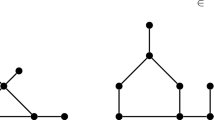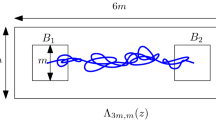Abstract
Characterization of some classes of graphs inducing periodic Grover walks have been studied for recent years. In particular, for the strongly regular graphs, it has been known that there are only three kinds of such graphs. As an extension of this result, we focus on the periodicity of the Grover walks on distance-regular graphs. The distance-regular graph is regarded as a kind of generalization of the strongly regular graph. In this paper, we find some classes of distance-regular graphs admitting a periodic Grover walk and obtain a useful necessary condition to induce periodic Grover walks. Also, we apply this necessary condition to give another proof for the classification of the strongly regular graphs.


Similar content being viewed by others
References
Brouwer, A.E., Cohen, A.M., Neumaier, A.: Distance-Regular Graphs. Springer, Berlin, Heidelberg (1989)
Brouwer, A.E., Haemers, W.H.: Spectra of Graphs. Springer, New York (2012)
Emms, D.M., Hancock, E.R., Severini, S., Wilson, R.C.: A matrix representation of graphs and its spectrum as a graph invariant. Electron. J. Comb. 13, R34 (2006)
Godsil, C., Royle, G.: Algebraic Graph Theory. Springer, New York (2001)
Gudder, S.: Quantum Probability. Academic Press Inc., Cambridge (1998)
Higuchi, Y., Segawa, E.: Quantum walks induced by Dirichlet random walks on infinite trees. J. Phys. A Math. Theor. 51, 075303 (2018)
Higuchi, Y., Konno, N., Sato, I., Segawa, E.: Quantum graph walks I: mapping to quantum walks. Yokohama Math. J. 59, 34–55 (2013)
Higuchi, Y., Konno, N., Sato, I., Segawa, E.: A note on the discrete-time evolutions of quantum walk on a graph. J. Math. Ind. 5, 103–109 (2013)
Higuchi, Y., Konno, N., Sato, I., Segawa, E.: Periodicity of the discrete-time quantum walk on finite graph. Interdiscip. Inf. Sci. 23, 75–86 (2017)
Inui, N., Konishi, Y., Konno, N.: Localization of two-dimensional quantum walks. Phys. Rev. A 69, 052323 (2004)
Kendon, V.M., Tamon, C.: Perfect state transfer in quantum walks on graphs. J. Comput. Theor. Nanosci. 8, 422–433 (2011)
Konno, N.: Quantum Walk. Morikita Publishing Co. ltd., Tokyo (2014)
Konno, N., Shimizu, Y., Takei, M.: Periodicity for the Hadamard walk on cycle. Interdiscip. Inf. Sci. 23, 1–8 (2017)
Kubota, S., Segawa, E., Taniguchi, T., Yoshie, Y.: Periodicity of Grover walks on generalized Bethe trees. Linear Algebra Appl. 554, 371–391 (2018)
Manouchehri, K., Wang, J.: Physical Implementation of Quantum Walks. Springer, Berlin, Heidelberg (2014)
Porugal, R.: Quantum Walks and Search Algorithms. Springer, Berlin, Heidelberg (2013)
Stefanak, M., Skoupy, S.: Perfect state transfer by means of discrete-time quantum walk search algorithms on highly symmetric graphs. Phys. Rev. A 94, 022301 (2016)
Yoshie, Y.: Characterizations of graphs to induce periodic Grover walk. Yokohama Math. J. 63, 9–23 (2017)
Acknowledgements
The author thanks to Etsuo Segawa and Yusuke Higuchi for supporting our research and giving us fruitful comments.
Author information
Authors and Affiliations
Corresponding author
Additional information
Publisher's Note
Springer Nature remains neutral with regard to jurisdictional claims in published maps and institutional affiliations.
Appendix
Appendix
In this part, we prove that distance-regular graphs with quotient matrices (21), and (22) are uniquely determined as \(K_{k, k}\), and \(K_{m, m, m}\), respectively.
First, we consider (21):
Let G be a distance-regular graph with quotient matrix (21). Then G is a k-regular graph. We fix \(x \in V(G)\). Then we have \(|\varGamma _{1}(x)|=k, |\varGamma _{2}(x)|=k-1\) by the relation of
for \(j \in \{0, 1, 2\}\) [1] and \(|\varGamma _{0}(x)|=1\), where \(\varGamma _{j}(x)\) is defined in Sect. 2. So any vertex in \(\varGamma _{1}(x)\) is adjacent to all the vertices in \(\varGamma _{2}(x)\) and vice versa, since \(b_{1}=k-1\) and \(c_{2}=k\). Put
Then \(|V_{1}|=|V_{2}|=k\), and \(\{ V_{1}, V_{2} \}\) becomes the complete bi-partition. Therefore, G is determined as \(K_{k, k}\).
Next, we consider (22):
Let G be a distance-regular graph with quotient matrix (22). Then G is a 2m-regular graph. We fix \(x \in V(G)\). Then it follows that \(|\varGamma _{0}(x)|=1, |\varGamma _{1}(x)|=2m\), and \(|\varGamma _{2}(x)|=m-1\) from (23). For a fixed vertex \(u \in \varGamma _{1}(x)\), put
Then we have \(|V_{1}|=|V_{2}|=|V_{3}|=m\) since \(|\varGamma _{2}(x)|=m-1\), \(a_{1}=m\) and \(u \in V_{3}\). We show that \(\{V_{1}, V_{2}, V_{3} \}\) becomes the complete tri-partition. From the definition of \(\varGamma _{1}(x)\), x is adjacent to all the vertices in both of \(V_{2}\) and \(V_{3}\). In addition, any vertex in \(\varGamma _{2}(x)\) is adjacent to all the vertices in \(\varGamma _{1}(x)\) since \(c_{2}=|\varGamma _{1}(x)|=2m\). So we obtain that any vertex in \(V_{1}\) is adjacent to all the vertices in \(V_{2} \cup V_{3}\). Then no two vertices in \(V_{1}\) are adjacent each other and we will show it for both of \(V_{2}\) and \(V_{3}\). Suppose that there exist \(u_{1}, u_{2} \in V_{2}\) such that \(u_{1} \sim u_{2}\). Since \(|V_{3}|=m\) and m edges from \(u_{1}\) extend to \(V_{1}\), there exists a vertex \(w(\ne u) \in V_{3}\) such that \(u_{1} \not \sim w\). It follows that \(u \not \sim w\) since m edges extend from u to \(V_{1}\) and the remaining m edges extend from u to \(V_{2}\). Now we retake \(\varGamma _{0}(w), \varGamma _{1}(w), \varGamma _{2}(w)\). Since both of \(u, u_{1}\) are not adjacent to w, it follows that \(u, u_{1} \in \varGamma _{2}(w)\). Moreover, it follows that \(u \sim u_{1}\) from the definition of \(V_{2}\), which contradicts \(a_{2}=0\). So it follows that any vertex in \(V_{2}\) is not adjacent to another vertex in \(V_{2}\) and so is any vertex in \(V_{3}\) since \(|V_{3}|=m\). Hence, \(\{V_{1}, V_{2}, V_{3} \}\) becomes the complete tri-partition and G is uniquely determined as \(K_{m, m, m}\).
Rights and permissions
About this article
Cite this article
Yoshie, Y. Periodicities of Grover Walks on Distance-Regular Graphs. Graphs and Combinatorics 35, 1305–1321 (2019). https://doi.org/10.1007/s00373-019-02059-6
Received:
Revised:
Published:
Issue Date:
DOI: https://doi.org/10.1007/s00373-019-02059-6




